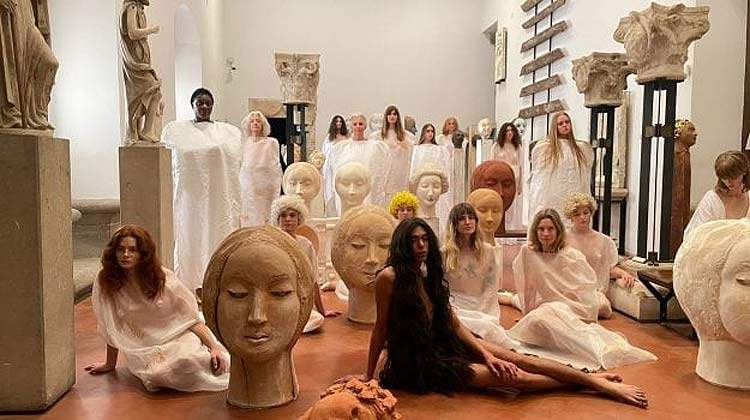Vanessa Beecroft’s performance VB94 was held yesterday, Dec. 8, 2022, from 6 to 9 p.m. at the Regional Gallery of Sicily at Palazzo Abatellis in Palermo: the public was able to admire a group of models and a series of unpublished sculptures made by the artist in her Los Angeles studio as a link between past and present, static and movement. The project, carried out in collaboration with the Associazione Amici dei Musei Siciliani and with the support of the Regional Department of Cultural Heritage and Sicilian Identity, was specially conceived by the artist for Palazzo Abatellis, which holds Sicily’s most important public collection of Renaissance art, transformed into a museum in 1953-1954 by Venetian architect Carlo Scarpa.
Once an aristocratic residence, then a cloistered convent for four hundred years, the palace is considered a masterpiece of international museology thanks to the exhibition design, conceived by Scarpa, which still retains all its innovative power. The performers of the performance evoke the women who have inhabited the mansion through the centuries, from the noblewomen of the Abatellis family to the nuns of the convent of Santa Maria della Pietà, who lived in the mansion until World War II, when the building was turned into a museum. The aim of the project was thus to pay homage to the collection and its original arrangement in a continuous dialogue with contemporary art.
The artist, who left Italy for the United States in 1996, returns to Palermo for the second time, after the performance VB62 in the former church of Santa Maria dello Spasimo in 2008, with a project that combines the memory of art history with her personal artistic experience gained also abroad. On this occasion, Vanessa Beecroft presented a number of heads modeled by her in clay and then reproduced in ceramic, bronze and wax. The bases of the sculptures were designed and made by the artist from reclaimed wood.
Referring to her artistic education that took place in Italy, Vanessa Beecroft’s research draws inspiration from classical art and the Renaissance sculptural tradition but also, at the same time, investigates the collective gaze on women and social pressures on the contemporary female condition. In 2008, on the occasion of VB62, a project conceived for the former church of Santa Maria dello Spasimo in Palermo, the artist introduced, for the first time, a new element in her research: a tableau vivant where, together with the models, she presented plaster sculptures created from live casts of those same women, in reference to both the Baroque sculptural tradition of Giacomo Serpotta and the theater of Carmelo Bene, the history of cinema and other iconographic references recurring in her work. As if in an ideal continuation of the never-ending relationship with Sicily and its historical and artistic heritage, for VB94 at Palazzo Abatellis, Vanessa Beecroft presented a series of figurative representations of women’s heads made and set up at the museum in such a way as to dialogue with both the collection and the models, as if they were an extension of the performance.
VB94 took place between the courtyard and the rooms dedicated to the museum’s sculptural collection on the ground floor of Palazzo Abatellis. Some of the performers wore white robes reminiscent of cloistered nuns. One of the models, lying on the ground with her body painted like a wooden sculpture, represented a penitent Magdalene. The performers are women from Palermo, some belong to the local aristocracy, others live in the historic center, and some are first- and second-generation migrants. All were placed between the rooms where sculptures carved in the 15th and 16th centuries are displayed, together with contemporary works by Vanessa Beecroft, as if they were a living reminder to their plastic counterparts. An original soundtrack composed for the performance by French-Swedish musician Gustave Rudman united and harmonized all the elements present in Palazzo Abatellis. The faces of the performers intended to recall both the Renaissance marble visions of Francesco Laurana, Antonello Gagini and the contemporary portraits of the women of Palermo. In a mutual correspondence, the performers of the performance, Vanessa Beecroft’s sculptures and works from the museum’s collection, share an identical tension toward an ideal of timeless beauty.
The project was conceived and produced by Vanessa Beecroft Studio - Los Angeles, with the participation of Galleria Lia Rumma, Naples/Milan and the support of the Planeta family. Beecroft’s presence in Palermo, Capital of Culture city in 2018, does not end there. The artist will unveil her personal interpretation of Caravaggio’s Nativity at the Oratorio di San Lorenzo on Dec. 24, as part of the Next project, a cultural initiative conceived by the Amici dei Musei Siciliani to keep alive the memory of the canvas painted in 1600 by Caravaggio, stolen from the oratory on the night of Oct. 17, 1969, and never found again.
Vanessa Beecroft (Genoa, 1969) has exhibited her work internationally since 1993. Her artistic research has defined performance art, the representation of the female body, and has addressed sociopolitical issues. Her exhibitions (entitled VB, followed by a progressive number) have been an ongoing research in progress for more than twenty-five years. Her performances, presented in some of the world’s most important museums and major contemporary events, highlight the tensions between nudity and clothing, constraint and freedom, collectivity and individuality, human strength and weakness.
Pictured is a moment from the performance
 |
| Vanessa Beecroft's new performance VB94 in Palermo: here's what it consisted of |
Warning: the translation into English of the original Italian article was created using automatic tools. We undertake to review all articles, but we do not guarantee the total absence of inaccuracies in the translation due to the program. You can find the original by clicking on the ITA button. If you find any mistake,please contact us.